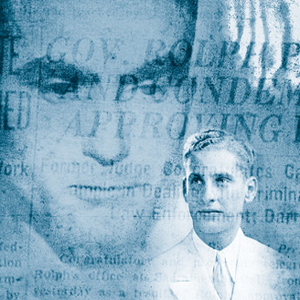The lynching of Harold Thurmond and Jack Holmes for the kidnap and murder of Brooke Hart in San Jose in November 1933 was a singular event in American history. Never before or since has the rule of law been so collectively subverted by law enforcement (including the FBI), public officials, community leaders, everyday citizens and the press.
This blistering scorn permitted up to 15,000 men, women and children to jam a city park, cheer an assault on the county jail across the street, witness and then celebrate two lynchings.
The exploitation of honest public feeling, and the surly contempt for the rule of law that gave rise to these lynchings, endures to this day—perpetuated by a materially flawed depiction of the guilt of the lynch victims who were never indicted or arraigned, much less tried for the crimes of which they were accused.
Incessantly, since the discovery, that crisp fall morning, of a terribly decomposed body in the San Francisco Bay determined to be the kidnap victim, radio stations had broadcast inflammatory bulletins about the lynching. A Los Angeles radio announcer featured the lynching as a “live event.” A San Jose movie theater projectionist placed a slide on the screen that announced that the lynching was about to start, and the patrons surged toward the exits.
Asked if he would order the National Guard to stop the lynching, Gov. James “Sunny Jim” Rolph retorted that he would pardon the lynchers. Two hours prior to the lynching, he canceled a trip to the western governors conference in Boise, Idaho, to prevent his chief political rival, the lieutenant governor, from using the National Guard because he had left the state.
Rolph was connected both personally and politically to San Jose through former state Sen. Louis Oneal. Fellow Republican Oneal, literally Rolph’s next door neighbor in the mountains on the west side of Santa Clara Valley, was the powerful overlord of the dominant county political machine.
During the assault on the county jail and the lynching, Oneal maintained an open phone line from his ranch to the jail in downtown San Jose; with him was Raymond Cato, appointed by Rolph as the chief of the California Highway Patrol. Three years previously, Oneal had handpicked San Jose Police Capt. William J. Emig to run for Santa Clara County sheriff, and got him elected.
Oneal had joined the sheriff and FBI agents in the interrogation of suspect Thomas Harold Thurmond. Ordinarily the sheriff would have provided Thurmond’s confession to the press, but it was released through Louis Oneal’s law office.
{pagebreak}
Swift Justice
Three generations after the lynchings, former San Jose Mercury reporter and columnist Harry Farrell wrote the insider account of the event: Swift Justice: Murder and Vengeance in a California Town.
In his introduction to Swift Justice, Farrell candidly acknowledged his bias toward the history with which he grew up: “I have used conventional wisdom about the case based on facts publicly aired … taking at face value the Thurmond and Holmes confessions.”
In acknowledgment of his hometown prejudice, Farrell paid homage to the dramatically compelling, yet factually tenuous, tapestry of guilt woven by law enforcement, community leaders, the governor of California, the citizenry and the press in November 1933 that created the foundation for the lynchings:
“Nowhere—neither street talk nor news reporting, nor official action—was the legal presumption of innocence even accorded lip service. The confessions of the prisoners were taken at face value; prospective efforts to repudiate them were dismissed out of hand.”
“In the court of public opinion, Jack Holmes and Thomas [Harold] Thurmond already stood convicted with no chance of appeal.”
Farrell had tried to attain the “literal truth” when he wrote Swift Justice, but freely admitted that his representation of facts ventured well outside commonly observed journalistic standards and practices:
“Where direct quotations are invented, their purpose was to enhance the truth. [W]hen sources are in conflict, obvious error, or incomplete, I have had to make educated guesses.
“Certain matters appearing in quotation marks do not meet the same standards of exactness … in a … contemporary news story. I freely acknowledge taking liberties … to produce a narrative in human terms.”
The acceptance of facts as “publicly aired” permitted Farrell to conform the available written record—newspaper stories, the FBI file on the kidnapping of Brooke L. Hart and personal interviews—with the time, place and action scenario detailed in the suspects’ confessions.
It also freed him from the objective analysis of facts that didn’t conform to what most people believed at the time of the lynching and allowed him to conclude: “The preponderance of the evidence supports the long accepted version of the events.”
Farrell acknowledged that he “had to deal with … inconsistencies which … cast a passing shadow” on his account of this historical event, but spent little time in the shadow. He accorded only superficial attention to the most obvious inconsistencies in the law enforcement version of the crime and the guilt of the two suspects, and failed to critically examine the most basic, yet glaring contradictions in the confessions.
{pagebreak}
Guilty Enough
Despite its seductive and compelling narrative force, one disquieting element among stark others in Swift Justice is the creation of a heretofore diabolically concealed criminal personality for Jack Holmes.
Holmes, husband and father of two young children, became, in the pages of Swift Justice some 60 years after his hot-blooded murder at the hands of a mob, suddenly possessed of a sinister criminal mind. To establish this pathology, Swift Justice relied on factually questionable, oblique and remote (in time), plainly superficial, idiosyncratic personal gossip that was not, and cannot be, corroborated.
Swift Justice transmogrified Holmes, who was also admirably described as, “A happy man with a promising future—well liked, recognized, and respected around town”—into the arch-evil manipulator of his partner and foil, Thomas Harold Thurmond, “who would happily stick his head in an oven if anyone asked him to.”
In contrast to Jack Holmes’ imagined criminal propensities, Swift Justice’s depiction of Thurmond was derived from family members and individuals with a lifetime familiarity with him; none of it was flattering. The one constant in Thurmond’s life was the severe head injury he had suffered as a young child.
An amalgam of the confessions and the contents of the first written demand from the kidnappers is the kicker to the discussion after the murder of Brooke Hart:
“Holmes withdrew a postcard and pencil from his pocket and, by the car’s dim dome light, laboriously printed in capitals a message to Alex Hart, Sr., composing it as he went along. It was the one which began “YOUR SON IS O.K. AND TREATED WELL. …” When finished, Holmes handed the card to Thurmond, who put it in his pocket along with Brooke Hart’s wallet.”
At the time this conversation had supposedly taken place, three witnesses stated Jack Holmes had been with them. The FBI analysis of ransom note handwriting released fifty years later determined that, although Thurmond and Holmes had both confessed that Holmes wrote all three ransom notes and letters, all had been written by Thurmond.
Persons unfamiliar with the factual inconsistencies in the confessions, the declarations of alibi witnesses, and the defiance of the laws of time and space that had to be manifested by Jack Holmes readily believe the “long accepted” and emotionally compelling version of the kidnapping and murder history memorialized in Swift Justice.
Swift Justice is an eye-opening case study of how the highly charged apologetics of Thurmond’s and Holmes’ guilt was still being exercised 60 years after their lynching.
Thurmond’s partnership with Holmes in the commission of a high profile, high stakes crime, in their own cars (Thurmond had to borrow the family car), on the streets of the city in which they had spent their entire lives, is so outlandish that it served, in 1933, and serves today, as the very reason for its credibility. It is simply so unbelievable that people believe it.
Its logical ungainliness was engineered by law enforcement in 1933 (echoed in Swift Justice) as evidence that only two culprits as sinisterly clever as Holmes and as moronic as Thurmond could have committed a kidnap and murder in such a bewildering and appalling manner.
In reality, its outlandishness is due to the case—both chronicled and imagined in Swift Justice—being jury rigged to convict the suspects in the court of public opinion.
{pagebreak}
Bumble and Bungle
Although Thurmond possessed limited mental capacity and emotional maturity, the FBI prompted members of the Hart family who had received the ransom calls to identify, by telephonic voice recognition, the dim-witted high school dropout as the man with “a soft, unhurried, well-modulated voice,” who made repeated ransom calls over six days.
To exercise such a pivotal role in the kidnapping, Thurmond would have had to express himself in a coherent and, for him, unnaturally confident manner. Confronted on the ransom calls by the skeptical and highly intelligent father of the kidnap victim, Alex Hart, Thurmond would have had to think on his feet. Given the uniform characterization of Thurmond’s mental acuity, it is doubtful that he had ever thought much on his feet, or in any other way.
Absent acknowledgment of its blatantly contradictory nature, Swift Justice relied upon the same pathologies asserted as the criminal bona fides of Holmes and Thurmond to also justify and explain why the kidnapping was, by even the most egregious examples of bone-headed criminal behavior, incoherently designed and implemented. Their “bumbling execution of the atrocity … verged on the comic.”
It was “comic” because the sheriff and the FBI had implanted the time, space and circumstance of the suspects’ confessions into a Procrustean bed of guilt.
Swift Justice created, as the foundation for Holmes’ gross criminal ineptitude, contradictorily enough, an imaginary criminal mind:
“To Jack Holmes, a flawless felony was something he admired … ; a botched crime was an affront. Holmes convinced himself he was smarter than those who had been caught.”
Holmes was the criminal mastermind who, when on a bridge only 18 miles from San Francisco where he planned to have the first ransom call made, drove over 40 miles back to San Jose before he ordered Thurmond to drive some 60 miles to San Francisco, make the ransom calls, throw the wallet into the bay and drive 60 miles back. Thurmond had to borrow his father’s car to do it.
Holmes, the criminal genius, made or ordered Thurmond to make ransom calls from pay phones within one-half mile of each other on consecutive nights in downtown San Jose during one of the most intensive law enforcement manhunts in California history.
Each time a ransom call was attempted, it had to go through a local operator. The Harts’ phone number had to be identified, and then there was a wait to be connected. Even this wasn’t sufficient to establish the kidnappers’ awe-inspiring lunacy; Thurmond was arrested on a telephone 150 feet from the San Jose Police headquarters.
There was more prodigious idiocy that literally rode around; Jack Holmes used his own car with his California license plates to carry out the entire crime.
{pagebreak}
Mob Motive
San Jose in the 1930s had a population of nearly 60,000 people, yet boasted 19,000 single-family homes, and only 400 apartments. Its remarkable middle-class wealth derived primarily from being the largest fruit and vegetable canning center in the nation. San Jose was middle class with a vengeance that manifested itself in a manner—the lynching—still unrivaled by any other middle-class community in the United States.
“San Joseans jealously cherished the symbols they perceived as confirmation of their culture: their twenty-one schools; their forty-six churches; the ivied tower and arcaded quadrangle of the teachers’ college [today, San Jose State University], and the Spanish-tiled buildings of the nearby University of Santa Clara.”
The beauty, safety, and relative economic security at the height of the Great Depression was something San Jose residents deeply valued and jealously guarded, and given their reaction to the kidnapping and murder of one of their own, something they defended and protected even at the cost of human life.
While today’s society is greatly inured to the graphic depiction of human depravity engorged by the news and entertainment media, the citizens of an agriculturally based community in the 1930s were stunned and horrified by, and took at face value, the descriptions of what was represented to have happened to Brooke Hart an hour and a half after he was kidnapped.
“Taken from a car on the San Mateo Bridge in the middle of the freezing San Francisco Bay at night, Brooke Hart was bashed on the skull twice with a twenty-two pound concrete block. He was then bound hand and foot with clothesline wire, had two of the concrete blocks tied to his feet, and was tossed off the bridge into the bay. One of the kidnappers climbed under the bridge to fire a volley of shots where he disappeared into the water.”
These images ignited the rage that resulted in the lynching of the two local men who had confessed to such atrocious acts.
The other volatile element stoking the anger of these otherwise decent citizens was the outsider press. At the time, San Jose was only of marginal interest to the many aggressive San Francisco newspapers, but once it was learned that the scion of a wealthy San Jose family had been kidnapped, ruthlessly competitive reporters swarmed the city.
They slavered for any details, factual and mendacious, lurid and antiseptic, that would bear their bylines and make their publishers happy through increased circulation.
Overnight, the peaceful, sleepy, bucolic, God-fearing, conservative middle-class enclave was under the microscope. Now, San Jose’s informal lifestyle and insider political and business decisions that were accepted as commonplace fell under the scrutiny of a politically uncontrollable press.
{pagebreak}
Jury Rigging
Because of the sheer horror of the acts to which both Thurmond and Holmes had confessed, discrepancies in the confessions were both ignored or dismissed out-of-hand. The public revulsion over the dispassionate admission, by two brazen opportunists out for a quick buck, about the brutal execution of an innocent young man established the foundation of fact that resulted—with the complicity of the powers-that-be and the press—in the lynching of Thurmond and Holmes.
In San Jose in 1933, as well as the rest of the nation, people were largely unaccustomed to, and unfamiliar with, the graphic, stomach-turning depictions of human violence that have dominated both the news and entertainment media over the last 40 years.
In 1933, such violent human-on-human imagery shocked people deeply, and the emotional response, unlike in the modern day, was not desensitized or hardened:
“Grief hung like a pall over Hart’s Department Store. Of the two hundred employees, their movements were automatic, their speech subdued, their throats tight from holding back emotion. Many wept openly, and were not ashamed.”
The citizens of San Jose read and gossiped about two greedy hometown miscreants who stupidly kidnapped, on a street where most people would know them, the high-profile son of a respected family. Barely 1 1/2 hours later, his skull was bashed twice with a 22-pound concrete block. He was then bound hand and foot, and tossed into the San Francisco Bay. When it appeared that he was still alive, one shot at him repeatedly from under the bridge.
The horror and enormity of such acts shook the people of San Jose to their core:
“The word of the murder fell like a thunderbolt, and on the heels of the stunned realization came a wave of intense anger. Groups collected in the street. Their faces grim. In step with the anger marched fear, lust for vengeance, jitters, sullen suspicion, and paranoia.”
Their revulsion was amplified when it was learned that Jack Holmes met his wife shortly after he murdered Brooke Hart, and then went to the movies with friends to share laughter as they watched Disney’s Three Little Pigs.
It was heightened by subsequent accounts of Holmes’s friendliness and jocularity as he went about his daily life, while at the same time, he allegedly orchestrated the extortion of ransom with the false and terribly cruel hope that the kidnap victim he murdered would be returned unharmed to his family.
Further outrage arose from reports that Thurmond had been seen next to his mother at church on the Sunday between the kidnapping, murder and his arrest.
Following the arrests, daily press accounts relentlessly stoked San Jose’s rage. Many people truly believed that Holmes and Thurmond were the “Human Devils,” described in an editorial published in the San Jose News.
As evidenced by the leadership role soon to be taken by the then governor of California, it was a foregone conclusion that the men were guilty, and destined to pay the ultimate price for their crimes.
Such extraordinary violence, brutal callousness and craven greed obviated the need for a trial; no jury in the world would fail to convict two such men and recommend the death sentence.
Unfortunately for Thurmond and Holmes, the confessions that convicted them in the court of public opinion were factually wrong, grossly misinterpreted and cynically devised.
John D. Murphy is the author of the book ‘Jury Rigging in the Court of Public Opinion’ on the Holmes and Thurmond lynching. He also wrote and produced the 2007 movie ‘Valley of the Heart’s Delight,’ which will be shown at the Camera 3 Cinema Sept. 17–24. Murphy will be available following the Thursday night screening for a discussion.
Cracks in the Case
The men lynched in St. James Park in 1933 were never tried, or even indicted. But a study of the facts shows that the case against them was flawed.
Abandoned Studebaker
The wife of the manager of the San Jose Country Club stated that she first saw a car abandoned with its headlights on near her home at 7pm the night of the kidnapping. Delphine and Isabelle Silveria had witnessed five men and the “light-haired driver” of the Studebaker stop some 30 feet from their barn at 6:30pm on the night of the kidnapping. They lived a mile and a half south from where the Studebaker was abandoned. They were the only eyewitnesses to the Brooke Hart kidnapping.
Verification of the Eyewitness Accounts
The FBI Brooke Hart kidnapping file contains a facsimile of a telegram sent to J. Edgar Hoover on the night of Nov. 13, 1933, after the eyewitness verifications: “Developments today indicate hart kidnapped by five men driving a large black sedan bearing California license.” In comparison to the long-hooded “large sedan” identified in the eyewitness accounts, Jack Holmes drove a black 1933 two-door Chevrolet coach. It was not until 50 years later, when the Brooke L. Hart kidnapping file was made public under the Freedom of Information Act, that this incendiary contradiction finally became public.
Brooke Hart’s Wallet
Thurmond confessed that after the 10:30 ransom call to the Hart family, he had walked down Market Street in San Francisco from the Witcomb Hotel to the Embarcadero, then south to Pier 32 where he had tossed Brooke Hart’s wallet into the bay. Whether Thurmond’s confession is taken at face value (as in Swift Justice), or assessed by objective fact, he could not have thrown Brooke Hart’s wallet into the bay. Thurmond confessed that he had tossed the wallet between 10:30 and 11pm on the night of the kidnapping. At the time he tossed the wallet off Pier 32, the oil tanker guardrail where it was found was still under water.
Thurmond Identifies
Brooke Hart
Thurmond and Holmes would have both recognized Brooke Hart, particularly since he drove only one of only two 1933 Studebaker President roadsters in San Jose. Jack Holmes’s father had custom tailored for L. Hart & Son for many years.
Holmes Wipes Off Fingerprints
For Jack Holmes to confess that he had wiped off fingerprints in the Studebaker (no prints of Thurmond or Holmes were found in Hart’s car), and at the same time to confess to the use of his Chevrolet with his license plates to execute the kidnapping, drive to San Mateo Bridge, park it while Hart was killed, use it to make ransom calls from different pay phones in downtown San Jose, and park it in the same garage where Thurmond made the ransom call that resulted in his arrest, defies both credulity and the argument in Swift Justice about Jack Holmes’s criminal expertise. The police searched Holmes’ car, but did not find the gun or Brooke Hart’s fingerprints.
Holmes Hits Hart on Head
Thurmond confessed that Holmes bashed Brooke Hart on the head twice with a 22-pound concrete block, while Holmes stated that he hit him with his fist.
Murder Method
Holmes confessed that Thurmond tied concrete blocks to Hart’s feet before they threw him into the bay off the San Mateo Bridge, while Thurmond confessed that he only bound him hand and foot with clothesline wire.
Unqualified Mastermind
Although Swift Justice portrayed Jack Holmes as the mastermind and Harold Thurmond as his foil, eyewitnesses for the purchase of the concrete blocks and a gun weeks before the crime imply that Thurmond was the “mastermind” of the Brooke Hart kidnapping.

 Kinch and Gauthier at Manresa
Kinch and Gauthier at Manresa  The Cypher at Johnny V’s
The Cypher at Johnny V’s 









